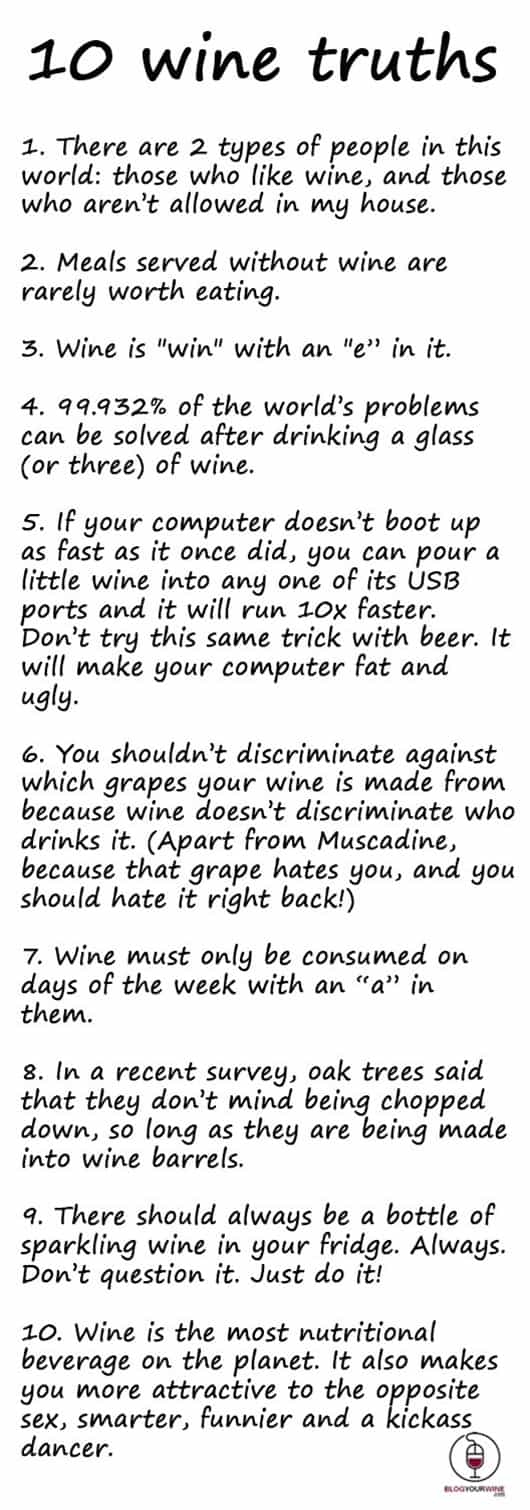What is Beaujolais?
Beaujolais [Boe-zjoh-lay] is a red wine made from a grape called Gamay. Yup! That’s where we already hit our first hurdle! There is no Beaujolais grape, contrary to what most people assume Beaujolais to be made from. This is always where consumers get confused, not just with Beaujolais, but with French wines in general i.e. between the grape and the region the wine comes from.
By French law, Beaujolais Nouveau is to be released no earlier than the third Thursday of November. Beaujolais must also come from the Beaujolais region, in the Southern part of the Burgundy region of France.
 Is Beaujolais made any differently than other wines?
Is Beaujolais made any differently than other wines?
Beaujolais Nouveau is made in the same way as regular Beaujolais, just a little quicker. The wine is normally ready to be poured down your kitchen sink…<ahem> I’m sorry! Did I say that out loud!?!? I don’t know what came over me!?!? Where were we?…In the case of Beaujolais Nouveau, the wine is “ready to drink” within 2 months of starting fermentation, (usually released on the 3rd Thursday in November every year).
There are a couple of different ways to produce Beaujolais, but they are all roughly based around a winemaking technique known as carbonic maceration. Carbonic maceration isn’t strictly reserved for the production of Beaujolais wine, but it also isn’t used too widely around the world.
Now, don’t get scared! I know carbonic maceration sounds all “wine sciencey and nerdy”…but…well…yeah, it’s VERY wine sciencey and nerdy, but a basic understanding of the process is critical to understanding Beaujolais.
- Carbonic maceration involves placing whole bunches of grapes in huge cement or stainless steel tanks which have had the oxygen removed.
- The weight of the grapes crushes the grapes at the bottom of the tank.
- Fermentation begins.
- Fermentation produces carbon dioxide, which in turn makes the enzymes in the grapes essentially attack itself and breaks the grape down further.
- This process is allowed to continue for 5-15 days and produces only about 3% alcohol in the wine.
- After this, the vat is drained, the fermented juice is separated from the skins, and the skins are pressed in order to extract tannin (but not much).
- The wine is then allowed to run a 2nd fermentation to raise the alcohol level, and to “smooth out the edges” on the wine.
 The History of Beaujolais
The History of Beaujolais
Beaujolais Nouveau was first produced in France during the 1930’s, but really first came onto the world stage in the 1980’s via well-known French winemaking chap going by the name of Georges Duboeuf. Mr. Duboeuf was a winemaker who obviously had a keen eye for making a profit, (selling wine a few weeks after its harvest is GREAT for keeping your accountant off your back!)
During the 60’s and 70’s he established a series of races in France to determine who could get the wine from the Beaujolais region to Paris the quickest. The rest of Europe and North America took up the challenge during the 80’s.
Some argue (mainly tree hugging hippies) that the speed at which Beaujolais producers get their product to the consumer is a concern, this since wineries around the world have been making huge efforts to reduce their “carbon footprint” on the environment. A bottle of Beaujolais Nouveau, it has been said, bears 4 times the carbon footprint than a regular bottle of wine. For this reason, Duboeuf within the past couple of years has made the decision to start shipping their wines by boat rather than by plane. Presently, George Duboeuf still remains the biggest producer of Beaujolais Nouveau.
 So how long can you keep Beaujolais/Beaujolais Nouveau for?
So how long can you keep Beaujolais/Beaujolais Nouveau for?
Beaujolais Nouveau should be consumed within 6 months of being bottled. Why you ask? Well, as mentioned previously, Beaujolais Nouveau tends to be lacking in tannins, and tannins give a wine the ability to age well. No tannins = less graceful aging.
Therefore, that bottle of Beaujolais Nouveau you’ve had collecting dust on your kitchen counter since last Thanksgiving…I hate to break the news, but it’s most likely dead.
Regular Beaujolais and Beaujolais-Villages (not Nouveau) should be consumed within 2 years of the vintage date on the bottle. Cru Beaujolais (we’ll get to that in a hot minute) is usually safe up to 3 years, but some can even last to 10 years depending on the vintage.
 So does all Beaujolais suck?
So does all Beaujolais suck?
Beaujolais has always been given a tough time by its critics…mainly because it’s an easy target!
French wine critic François Mauss was famously quoted as saying the reason for declining Beaujolais sales, was due to the poor overall quality of Beaujolais Nouveaux, using the term vin de merde (sh*t wine). To illustrate this even further, in 2001, more than 1 million cases of Beaujolais Nouveau were destroyed due to poor sales.
There are however 10 Cru Beaujolais regions i.e. the best wine zones for Beaujolais. It’s worth noting that Beaujolais Nouveau is not produced from the grapes in these regions, so don’t judge all Beaujolais based on previous experiences with Nouveau! Wines from these 10 Crus are overlooked by consumers as they normally don’t bear the term Beaujolais on the front label, instead they usually just list the name of the appellation e.g. Morgon (however French labeling wine law is changing as we speak, so watch this space!).
Something else to bear in mind, Beaujolais (whichever its type) should be served slightly chilled (55°F is ideal), in order to best show off its fruit-forward nature. 10-15 minutes in the fridge should do the trick. My advice this Thanksgiving season, if you ABSOLUTELY HAVE TO HAVE BEAUJOLAIS, is go for the Cru!
 Below is a list of the 10 Beaujolais Cru appellations, complete with pronunciations. If you’re going to buy Beaujolais, the first 4 in bold are the better known regions that you should seek out from your local wine store:
Below is a list of the 10 Beaujolais Cru appellations, complete with pronunciations. If you’re going to buy Beaujolais, the first 4 in bold are the better known regions that you should seek out from your local wine store:
Brouilly [BREW-yee]Fleurie [FLUR-ee]Juliénas [ZJOO-lee-ay-nah]Morgon [more-GOH]Chiroubles [shee-ROOB-luh]Chénas [shay-NAH]Côte de Brouilly [coat duh BREW-yee]Moulin à Vent [MOO-lan ah vahn]Régnié [reh-N’YAY]Saint Amour [sant ah-moor]
Science part of article produced with a little help from: Understanding Wine Technology: The Science of Wine Explained by David Bird



all about Bacchus
This article leaves the impression that all Beaujolais Nouveau is good for the sink. While it is true that the great majority is, there are many producers (e.g. Marcel Joubert, etc) who make excellent BN that would compare favorably to many non Nouveau wines. This article obviously being intended for the neophytes, a little objectivity would have been welcome.
Kris Chislett
I tend to put a lot of faith in people who read my work also knowing that I have a fairly dry sense of humor. Without being able to poke a little fun at the occasional wine or two it wouldn’t be worth doing what I do.